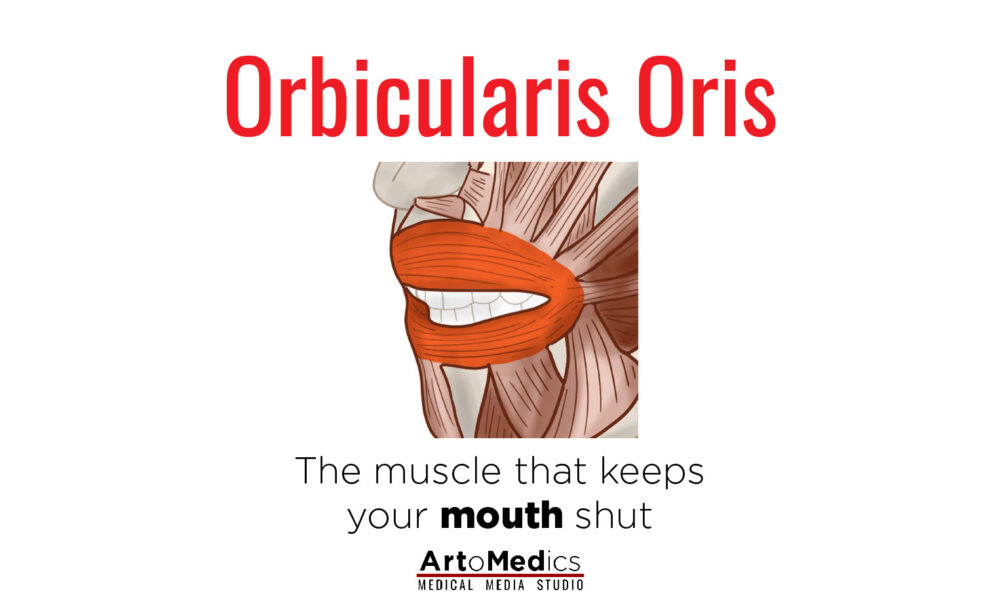Orbicularis Oris Muscle: One of a kind sphincter in the face

Have you wondered why you can pucker your lips, you can kiss and whistle? Its because of the Orbicularis Oris muscle.
Orbicularis Oris muscle is an sphincter type of muscle that encircles the mouth. In other words, it’s one of the circular muscles of the lips.
It’s the muscle that keeps helps you hide your teeth, and keep your mouth shut.

You can download our Orbicularis Oris Muscle deck for free, available as JPG to take it your phone or print, to help you study. Just fill in the form.
It’s not as simple as Orbicularis Oculi, the sphincter in the eye, it has fibers derived from other facial muscles inserted into the lips, which it does account for the lips being able to take many more shapes and movements than just close and open the mouth as the eyelids do with Orbicularis Oculi.
I wonder where down the line of evolution this muscle just began grabbing the odds and ends from the other muscles attached to it and said “hey wouldn’t it be cool if we all got together and do fun stuff like smile and help make certain sounds?”

What Orbicularis Oris is capable of
Besides the obvious function of opening and closing the mouth, there’s so much more that Orbicularis Oris muscle is involved into. Certain music brass music instruments such as trumpets, cornets and horns and woodwind musical instruments such as saxophone, flute and clarinet.
Orbicularis oris muscle is also called “the kissing muscle” because of it’s involvement in kissing and puckering the lips.
Also, this muscle covers your front teeth. In fact, having a thick upper quadrant of the orbicularis oris is associated with upper lip retrusion.
Where the name comes from
It was name Orbicularis just like the eyelids muscle sphincter, because at first it was thought that it was a simple sphincter, but now it is known that it’s so much more than that, and that it’s actually divided into four quadrants: upper, lower, left and right. and each has a larger pars peripheralis and pars marginalis.
The peripheral and marginal parts can be linked externally to the lines of junction of the skin and the the vermillion zone of the lips.
So, bottom-line is that it’s not a simple sphincter, it’s actually made up of 8 segments, that look like a fan with a stem and that opens up in peripheral segments and closes at marginal segments.
It’s actually made up of 8 segments, that look like a fan with a stem and that opens up in peripheral segments and closes at marginal segments.
What is an Sphincter?
A sphincter is a muscle that has a circular shape and normally is used as a gate, it’s there to keep a hole shut, like the eyes and anus.
What muscles converge into Orbicularis Oris?
- Part of the buccinator
- Fibers from the lips themselves,
- Quadratus labii superioris
- Zygomaticus
- Labii inferioris

Orbicularis Oris Basics
Innervation
Orbicularis Oris is supplied by the mandibular nerve and buccal nerve, both branches of the facial nerve.
- Branches of the Facial nerve
- Buccal nerve
- Mandibular nerve
Blood Supply
- Branches of the Facial artery
- Superior Labial artery
- Inferior Labial artery
- Branches of the Maxillary artery
- Mental artery
- Infraorbital artery
- Branches of the superior temporal artery
- Transverse facial artery
Drains into tributaries of the Facial vein
Muscle Attachments
Muscle origin
Maxilla and Mandible bones
Muscle Insertion
Skin surrounding the lips.
Reference
Standring, Susan. Gray’s Anatomy: The Anatomical Basis of Clinical Practice. , 2016. Print.

Leave a Reply